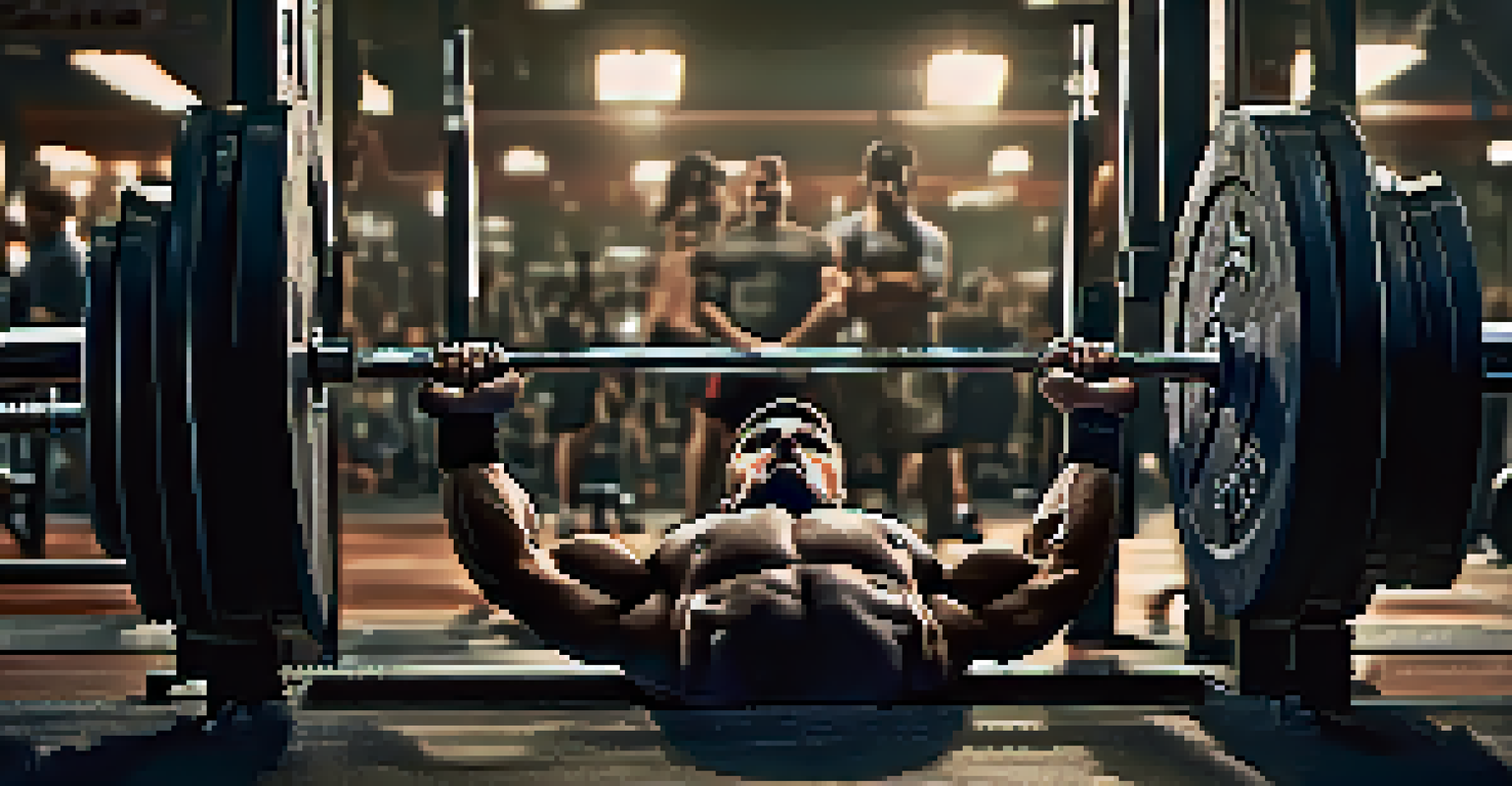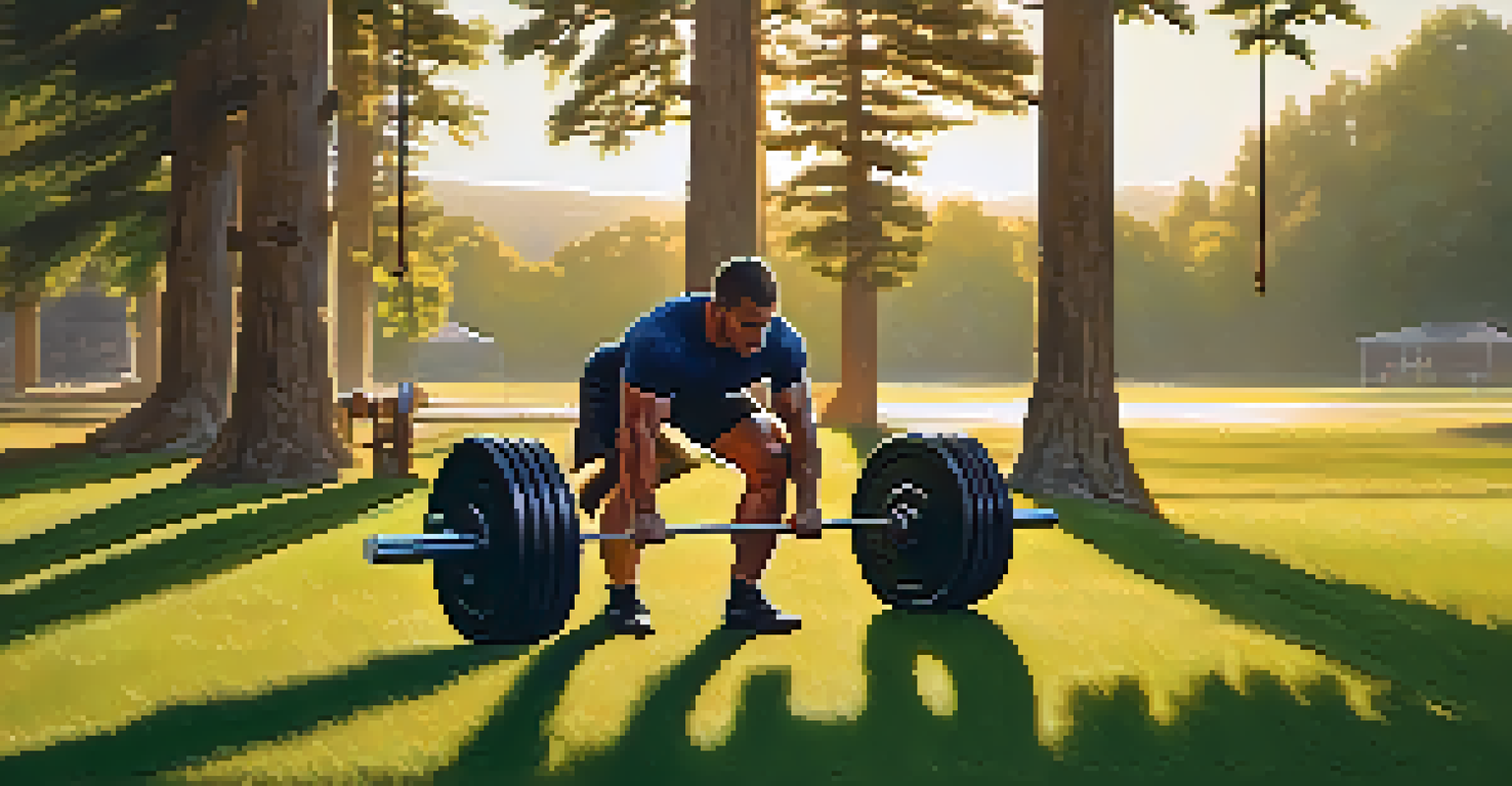Mastering the Art of Powerlifting: Essential Training Techniques

Understanding the Basics of Powerlifting Techniques
Powerlifting focuses on three core lifts: the squat, bench press, and deadlift. Mastering these movements is crucial, as they form the foundation of the sport. Each lift targets different muscle groups, so understanding their mechanics is vital for effective training.
Success is where preparation and opportunity meet.
For instance, the squat primarily engages the quads, hamstrings, and glutes, while the bench press works the chest, shoulders, and triceps. The deadlift, on the other hand, is a full-body movement that emphasizes the posterior chain. Knowing how these lifts function will help you structure your training to improve overall strength.
By grasping the fundamentals, you set yourself up for success. It's like learning to ride a bike; once you master balance, you can tackle more complex maneuvers.
Developing a Structured Training Program
Creating a structured training program is essential for progress in powerlifting. This program should include not only the three main lifts but also accessory exercises to target weaknesses and enhance overall strength. A well-rounded approach ensures all muscle groups are engaged.

For example, if you struggle with your bench press, incorporating tricep dips and shoulder presses into your routine can help strengthen those supporting muscles. Furthermore, varying your rep ranges and intensity levels can prevent plateaus and keep your workouts fresh.
Master the Core Lifts for Success
Understanding and mastering the squat, bench press, and deadlift is essential for building a strong foundation in powerlifting.
Think of your training program as a roadmap; it guides you toward your destination—improved strength and performance. Consistency and adaptation are key to navigating this journey successfully.
The Importance of Proper Form and Technique
Proper form is paramount in powerlifting to prevent injuries and maximize performance. Each lift has specific techniques that need to be followed, such as keeping your back straight during deadlifts or ensuring your knees don't collapse during squats. Focusing on form early on sets a solid foundation for heavier lifting.
The only way to prove that you are a good sport is to lose.
Practicing in front of a mirror or recording yourself can help identify areas for improvement. Additionally, enlisting the help of a coach or experienced lifter can provide valuable feedback and tips. Remember, lifting heavy weights is not worth sacrificing your body.
Consider proper form as the bedrock of your lifting journey. Just as a house needs a strong foundation to withstand storms, your lifts need solid technique to handle heavy weights.
Incorporating Accessory Lifts for Balance
Accessory lifts are crucial for addressing muscle imbalances and improving overall performance in powerlifting. These lifts target smaller muscle groups and assist in the strength of your main lifts. For example, lunges can enhance squat strength, while bent-over rows can bolster your deadlift.
By integrating accessory exercises into your routine, you not only improve your lift performance but also reduce the risk of injury. It's akin to building a well-rounded athlete; focusing solely on the main lifts can lead to weakness in supporting muscles.
Nutrition Fuels Performance and Recovery
A balanced diet rich in macronutrients is crucial for optimal performance and recovery in powerlifting.
Think of accessory lifts as the seasoning in your training recipe. They enhance flavor and prevent your workouts from becoming bland and repetitive.
Nutrition: Fueling Your Powerlifting Journey
Nutrition plays a vital role in powerlifting performance and recovery. Consuming the right balance of macronutrients—proteins, fats, and carbohydrates—ensures your body has the fuel it needs for intense training sessions. Proper nutrition also aids in muscle recovery, allowing you to hit the gym hard again sooner.
For example, a post-workout meal rich in protein can help repair muscles, while carbohydrates replenish energy stores. Staying hydrated is equally important; dehydration can impair strength and performance, making it harder to achieve your goals.
Think of your body as a high-performance car; without the right fuel, it won't run optimally. Prioritizing nutrition keeps your engine running smoothly during your powerlifting journey.
Rest and Recovery: Key Components of Training
Rest and recovery are often overlooked but are critical components of any successful powerlifting program. Your muscles need time to repair and grow stronger after intense workouts. Ignoring recovery can lead to overtraining, injuries, and burnout, ultimately hindering your progress.
Incorporating rest days, stretching, and even activities like yoga can enhance recovery. Listening to your body is essential; if you're feeling fatigued, it's okay to take an extra day off or dial back your intensity. Remember, progress is not just about lifting more weights—it's also about allowing your body to recover.
Rest is Essential for Progress
Incorporating adequate rest and recovery into your training program is vital for avoiding injuries and enhancing strength gains.
Think of recovery as the pause between musical notes. Just as silence enhances the melody, rest amplifies your strength gains and prepares you for the next challenge.
Setting Realistic Goals and Tracking Progress
Setting realistic goals is essential in powerlifting, as it keeps you motivated and focused on your training journey. Start with achievable benchmarks, like improving your squat by a certain percentage or mastering your form on a specific lift. This not only helps you stay committed but also allows for celebrating small victories along the way.
Tracking your progress is equally important. Keeping a training journal or using apps can help you monitor your lifts, identify patterns, and make necessary adjustments to your program. Seeing tangible improvements can be incredibly motivating, pushing you to work harder.

Think of goal setting and tracking as the compass of your powerlifting journey. They guide you, ensuring you stay on the right path toward your ultimate strength aspirations.